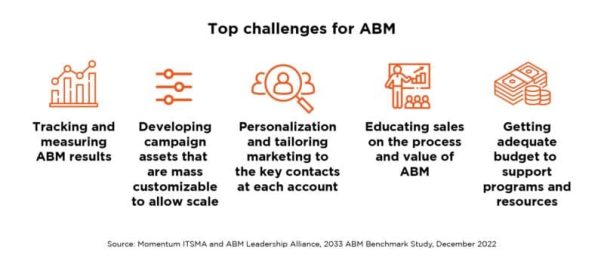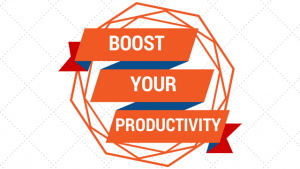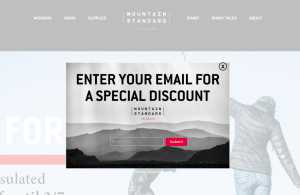Interest in ABM strategies is surging as technologies to target key accounts improve and relevant data becomes more accessible.
By definition, account-based marketing (ABM) is a B2B marketing strategy that aligns sales and marketing efforts to deliver targeted advertising, as well as personalized content and messaging, to high-value accounts and especially to individuals associated with those accounts.
This is based on the recognition that B2B purchase decisions are often made by a group of individuals within the company. ABM tools automate many of the data and workflow processes that enable these groups to be targeted.
ABM isn’t new, though. It has been used by B2B marketers for well over a decade. But rapid advances in the sophistication and accessibility of relevant data — and in the technologies that today enable ABM — are now fueling widespread interest in and adoption of this approach.
In this piece we’ll answer these questions and more:
- What are the types of account-based targeting?
- What do account-based marketing tools do?
- What are the benefits of using account-based marketing tools?
- How do I decide if I need an account-based marketing platform?
- Why does account-based marketing continue to grow?
- Why has account-based marketing adoption accelerated during the pandemic?
What are the types of account-based targeting?
A successful ABM strategy aligns sales and marketing departments to focus on high-value accounts that represent the highest potential business opportunity. ABM “flips” the typical sales funnel by starting with a small group of identified accounts (rather than casting a wide net at the top) that widens as accounts are nurtured down into the funnel.
Many factors go into choosing targeted accounts, including history with the business, and whether the account is growing or in a growth-oriented market. One of the most important criteria is whether it fits the business’s Ideal Customer Profile (ICP).
An ICP is typically developed using predictive analytics and scoring to determine if an account (not an individual) is an ideal fit for a company’s product or service. The ICP should consider relevant characteristics including industry/vertical, size (both employee number and annual revenue), budget and geography.
Once sales and marketing teams have agreed upon the list, there are typically three types of ABM targeting that can be executed. They are not mutually exclusive, and many companies use more than one. They have been defined by the Information Technology Services Marketing Assocation (Momentum ITSMA) as follows:
- 1-to-1. Also called “Strategic ABM” by Momentum ITSMA, marketers work with account teams to develop and execute highly customized programs for each target account (i.e., face-to-face or virtual meetings).
- 1-to-few. Also called “ABM Lite” by Momentum ITSMA, marketers execute less customized programs for clusters of target accounts with similar needs or business attributes (i.e., email marketing campaigns, in-person or virtual roadshows and events geared toward groups).
- 1-to-many. Also called “Programmatic ABM” by Momentum ITSMA, marketers use AI-driven automation to send highly targeted and personalized messages to individuals at hundreds (or thousands for enterprises) of key accounts (i.e., email, web content personalization, digital advertising and retargeting, live or virtual events for large groups).
What do account-based marketing tools do?
A wide variety of ABM tools are available to automate and execute ABM strategies. These include tools that provide B2B data enrichment, AI-based predictive analytics and recommendations, interaction management (i.e., digital advertising, direct mail, websites, events and sales outreach) and ABM infrastructure and orchestration.
Since data enrichment is a chief capability of ABM tools, it’s first to understand the types of data these platforms work with:
- Firmographic data. Provides quantitative business information, including vertical market, company size and number of locations, number of employees, annual revenue and growth.
- Intent data. Identifies company actions or signals that indicate whether or not an account is “in market” for a product or service.
And of relevance to technology vendors:
- Technographic data. Identifies the hardware and software systems that accounts use to run their businesses (relevant for tech vendors).
Now, let’s dig into all of the capabilities and the key considerations involved in choosing an ABM tool.
Data enrichment
Effective ABM begins with robust, accurate account data. While many B2B companies collect vast amounts of first-party data, there are often gaps that can negatively impact efforts to customize content or offers for target accounts. Some vendors and their partners provide very specific types of business data, as well as broad-based business data, that can provide important insights into purchase intent.
Account-based marketing targeting
ABM programs can target key accounts at the 1-to-1, 1-to-few and 1-to-many levels. The targeting precision needed will depend on the size and scale of the ABM efforts: SMBs may need a 1-to-many approach because of the number of contacts or influencers at their target accounts, while larger enterprises may find that 1-to-1 targeting allows them the customization necessary to successfully nurture a key account. Most vendors provide machine learning and the granularity to enable more than one level of account targeting.
Personalization and/or predictive recommendations
B2B buyers expect personalized messaging and offers from the companies they do business with. Some vendors use proprietary AI to allow customers to create and execute highly personalized campaigns and programs. On the other hand, many vendors integrate with third-party personalization tools or CRM platforms that drive these types of customized programs.
Interaction management/orchestration
B2B marketers must engage target accounts on multiple channels with highly customized and consistent ABM programs. Effective B2B channels include both offline (direct mail, events, roadshows and in-person/phone-based sales outreach) and online (email, websites, virtual events, video calls, webinars and paid/organic search, display ads and social) media.
Many vendors manage ABM interactions, including offering cost per click-based paid ad programs across search, display and social media.
Account-based marketing reporting
Although it is a time-tested strategy, ABM is still new to many B2B organizations, and, even for those that have been doing ABM, there’s still plenty of room for expansion and integration. As a result, measuring and reporting on program success will be vital for ongoing C-suite support, as well as securing sales team buy-in.
Vendors are expanding their reporting capabilities through investments in AI to provide faster, deeper and more visual analytics that can highlight performance trends and patterns (highest performing geographic locations or company characteristics, for example). In addition, more vendors are providing reports at both the account and individual/contact level.
Third-party software integration
Vendors are aggressively expanding their application architectures through native integration and APIs to offer B2B marketers streamlined access to the third-party systems already in their technology stacks. Native or out-of-the-box integrations are most commonly available for CRMs and marketing automation platforms, although many tool vendors also offer plug-and-play access to event platforms and content management systems (CMSs).
Several tools are specifically customized for Salesforce integration and use. API integration may incur additional charges, generally on a per-call basis for each data download.
What are the benefits of using automated ABM tools?
Automating ABM data, analytics, campaigns and workflow processes can provide numerous benefits, including the following:
- Improved sales and marketing alignment.
- Shortened sales cycles.
- Increased marketing ROI.
- Expanded account value and revenue.
- Significant boost to pipeline velocity and closed rates.
- Enhanced customer experiences.
How do I decide if I need an ABM platform?
Deciding if your company needs any marketing software application starts by answering a couple of simple questions. Deciding if your company needs an ABM platform is no exception. Assess your organization’s business needs, staff capabilities, management support and financial resources.
These questions will help you determine the answer.
- Have we identified our account-based marketing goals?
- Can sales and marketing agree on the list of target accounts?
- Do we have management buy-in?
- Are we including all of the costs?
- Are we prepared to measure and report results?
Why does account-based marketing continue to grow?
Whether it’s streamlining communication between marketing and sales or creating more personalized web engagement with target prospects, ABM technology offers the ability to build out critical relationships.
Although inbound marketing remains critical to B2B lead generation, many marketers are increasing their use of account-based marketing to take back some control of the process, speed up the buying cycle and find better ways to convert target accounts. Here are some positive business impacts reported by ABM users:
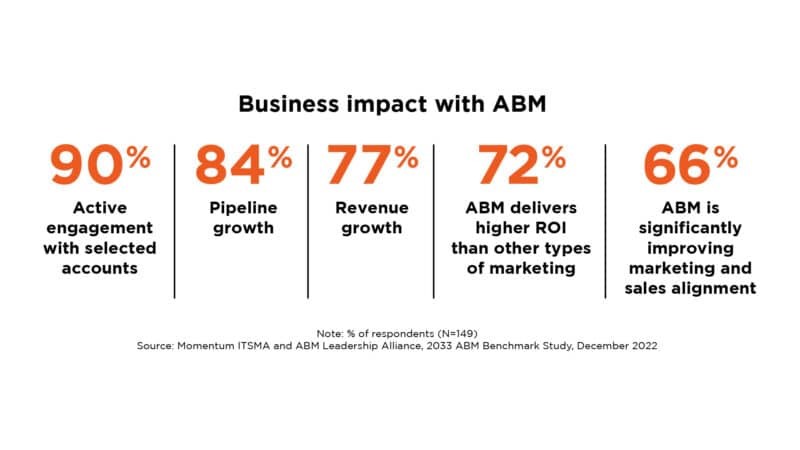
No wonder many businesses will be increasing ABM spend and staffing in 2023:
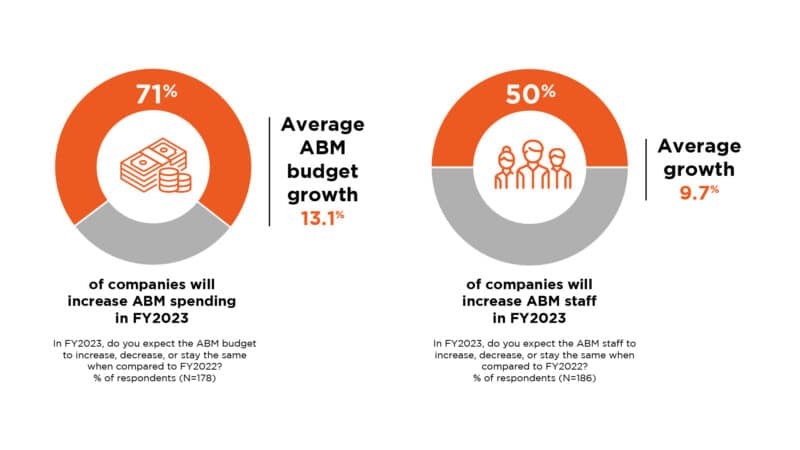
Still, challenges remain. Here are the critical ones, according to Momentum ITSMA and the ABM Leadership Alliance:
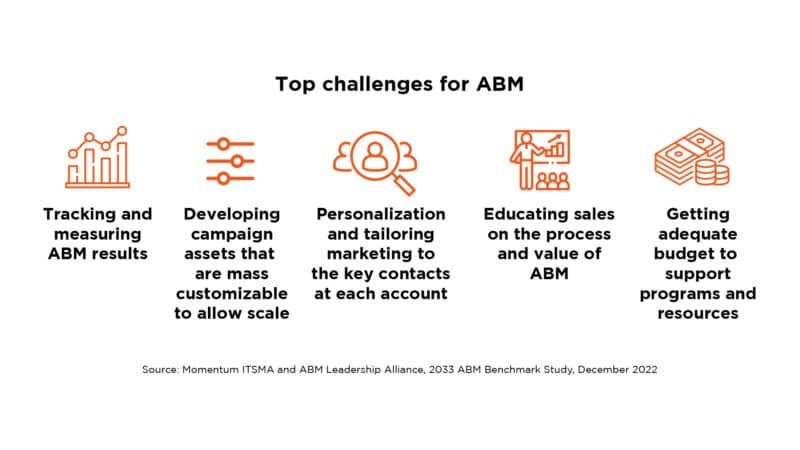
Why has ABM adoption accelerated during the pandemic?
We heard a lot about how dramatically the pandemic affected consumer purchasing behavior, but the business-to-business side of buying is less frequently discussed. That doesn’t mean the pace of developments was any slower, however.
We learned about how B2B buyers were engaging with companies in the lockdown environment, and how marketing technology providers helped those companies turn prospects into customers.
While ABM has been used by B2B marketers for well over a decade, rapid advances in the sophistication and accessibility of relevant data — and in technologies that enable ABM — are fueling more widespread adoption of this approach. Another driving force, which I mentioned at the start, are fundamental changes in the B2B buying cycle — shifts that the COVID pandemic accelerated as events and in-person meetings went virtual.
The post What is account-based marketing or ABM and why are B2B marketers so bullish on it? appeared first on MarTech.
(7)
Report Post